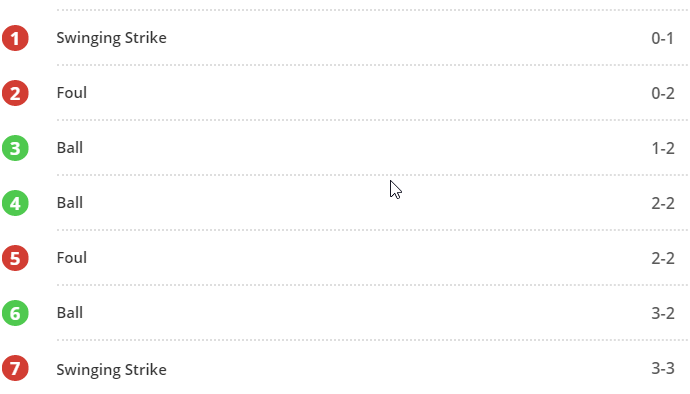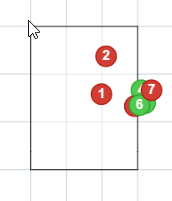[A few weeks ago, in McLovin It, I wrote, “(A.J. Vukovich) is looking like a developing young slugger usually does.” I want to retract this statement and replace it with the following, please.]
The 19-year-old Vukovich started his Visalia (low-A) assignment 3-for-34 with 3 HR, 10 strikeouts, and zero walks in seven games. Vukovich is 6’5″, 210 pounds, Youtube-famous via a 2019 high school home-run derby in Cleveland, and a somewhat surprising 2020 fourth-round pick. It might be easy to pair these things and assume a beefy young slugger swinging for the fences. Well, we’ve got four weeks of a pro career, and the somewhat mysterious prospect is revealing himself…even to Wisconsin baseball stans like myself, but perhaps misunderstood what AJV is all about, or figured we’d get to know him in Louisville.
Since the 3-for-34 (.083), Vukovich has hit .356 with a .462 OBP and one home run. What made the difference? Anything? Answers are blurry and choppy like the following gifs. To boot, only half of AJV’s games have been broadcast and half of those were in Modesto, which, as you’ll see…not always the most telling. That’s the nature of the beast…mudding down in the low-As. But let me share what I’ve seen:
Important to note, horribly inaccurate pitch plotting exists in milb.com. This at-bat vs Robinson Hernandez, 5/11, illustrates the kind of inaccuracies you’ll come across, specifically pitch six:



Juuuust a bit…outside?…you mean high? Yet, in my viewing and quality control, milb.com gameday is fairly accurate denoting, generically, pitches in and outside of the zone, just not very accurate with specific location, especially inside the zone. According to the plots, darn near 100% of the balls put into play or swung on in Low-A West have been in the heart of the zone. Not true.
Often a pitch, say down and away and swung on, will get plotted in the “down and away” portion of the middle-middle ninth. If a pitch is plotted on a border, chances are it was out of the zone. I’m sure these things vary league to league or park to park, but these have been my takeaways watching weeks of Low-A West games.
So using my eyeballs and translating plots of untelevised at-bats, we can take some things away about AJV. During the 3-for-34, there was a lot of the following:

(vs Will Ethridge 5/14)
…a .125 BABIP…and a 29.4 K%…
 (vs Dugan Darnell 5/14)
(vs Dugan Darnell 5/14)
We are talking about a minuscule 34 plate appearances (120 pitches) during this stretch, so the numbers don’t mean much, but there are worthy notes to take. AJV saw 3.53 pitches per AB. The average count at the time of BIP was 1.06 balls and 1.24 strikes. AJV swung at roughly 54% of the pitches he saw and approximately only four to six of them were chased out of the zone. AJV is looking to do damage, but isn’t a swing-hard-at-everything, try-and-murder-the-ball teenager. This at-bat vs Mike Ruff (5/16), even though it ended poorly, is a good example (the half-check swing was one of his “chases”):

Milb.com Gameday also offers questionable hit plotting. Balls hit to “center field” can vary from balls actually being hit to left or right fields, even down the line. Regardless, taking out anything labeled “center field”, AJV’s generic spray chart was something like 50% pull-rate, 33% opposite field with the remainder (17%) being up-the-middle/inconclusive.
If there was such a thing as a pivotal moment for AJV this May, it was this two-strike base hit against Breiling Eusebio (5/15); a nice and easy, get-the-good-part-on-it-and-take-what-you’re-given swing:

Hitting the ball the other way wasn’t suddenly a new idea after this single, but maybe the approach felt more comfortable. AJV’s spray chart post 5/15 was more 33%/33%/33%, and pitchers were still primarily trying to pitch him down and away. A few teams tried to bust him inside more, which was not a plan of attack the first seven games. Pitchers had success doing so as well, so I’m curious how that goes moving forward.
AJV has been an aggressive hitter and during the hot streak, he’s actually seen fewer pitches per at-bat. AJV was maybe slightly more selective, swinging at 48% of the pitches, but he was able to find himself in more favorable counts. Perhaps his pitch recognition improved while keeping the all-fields approach, but the BABIP shift to roughly .500 didn’t hurt. He chased a tad more, but he faced some tougher breaking balls and was ahead more, taking the liberty to be more aggressive. The six walks were matters of getting pitched around or control issues. They were not very challenging at-bats. AJV doesn’t look to be on the path of a big walk guy. Here’s a look at AJV being aggressive 0-0:

(vs Mike Ruff 5/16)
Some more opposite-field success with two strikes:

(vs Stephen Jones 5/16)

(two strikes vs Connor Phillips 5/26)
And it wasn’t all singles…

(two-RBI double vs Connor Phillips 5/26)

(three-RBI double vs Jorge Benitez 5/26)
And he wasn’t over-matched when he ran into a tough pitcher:

(A rare chase for AJV, vs Adam Macko)

(vs Macko 5/27, who was striking out guys left and right)

(Home run vs Sam Carlson 5/29, 103 mph off the bat, 429 feet)
AJV packs a lot of country strength. Sure he’s big, but he isn’t a physically sculpted specimen. He’s lean still, which is scary, even more strength will come. We aren’t talking about over-the-top athleticism here, he’s got a little Hunter Pence feel to him in the shoulders and lacks the pretty boy power swing of, say, Zac Veen, but 99 mph off the bat comes pretty easy here:

(single, 99 mph off the bat vs Elvis Alvarado)
Add the more old-school, closed stance, and AJV is a different cat up there. Sure, AJV is still very raw, but unless he suddenly became this version, which seems unlikely given instruct reports, some of these optics may have played into his fourth-round status. AJV feels on par or more advanced than a lot of his more esteemed high school draft peers.
We know power won’t be a problem, and a young man trying to grow into a legit hitter is all kinds of exciting. At this point, I have to consider AJV one of the best teenage hitters in full-season ball right now and moving forward. Defensively, things at third base are questionable. AJV has a good arm, but I’m skeptical he turns into a major league hot corner option. There have been three stolen bases, but that’s definitely not a thing as he matures. The bat will have to play, but the bricks are being laid for a potential middle-of-the-order power threat who also hits for average. AJV owners might be coming up cheddar, at least this month they did.
Design by Michael Packard (@designsbypack on Twitter @ IG)


The first thing to understand about the 2020 draft is that it was based on close to nothing. There were showcase kids from CA anf FL but the rest of the pack just didn’t get scouted worth anything. Same with college, maybe you had a big series in the month they played, and maybe you didn’t. Pull up a early projected first round from a previous year and compare it to the actual first round and it is laughable. My point is that players drafted in rd 1 would have slid way out and many would have gone drafted – you also have 3rd and 4th rounders that would have gone in round 1 last year if they played real baseball. I think of the 2020 draft as just more random than not. I don’t really look at draft position that much as it was surely terrible. That said, I dug into probably the top 2-300 draftees last year as simply looking at round one is not going to get you far. I did have AJV as a player to follow. I approve of the nickname because his name is long. I think it is fair to say that in 2020 the lower ceiling, polished kids (showcase kids that peaked when they were 15 and have gotten lots of looks) went high and the toolsy busty types slid. What is interesting is that big, projectable kids like AJV are non uncommon and they are a bad bet but without the season none of them had an opportunity to show how hopeless or improved they were. These kind of kids are a bad bet but at least they have upside. I certainly don’t see any Hunter Pence in him, but I don’t see any huge red flag in the way that he swing the bat. He is tall and skinny – you just don’t know how that turns out. You are much higher than I am on him and I like him. In a league with 500 rostered specs, he went undrafted. I didn’t draft him because I figured he is so far away that it would be a waste of a roster spot. I think he is most likely to have some struggles and figure it out later. Honestly, I have been doing this for long enough to not be very excited as these things usually flame out in the mid minors. I really don’t have anything bad to say about the way he swings the bat – it is his height that concerns me the most as he doesn’t appear to be a super coordinated athlete and the road usually isn’t smooth for folks with arms that long. There are more things to like here than not, but it is all so far away. On guys like this, I think acquiring them when they are in the mid-minors is usually a good move as they often stall out for a bit. Nice choice of player here as he isn’t well known.